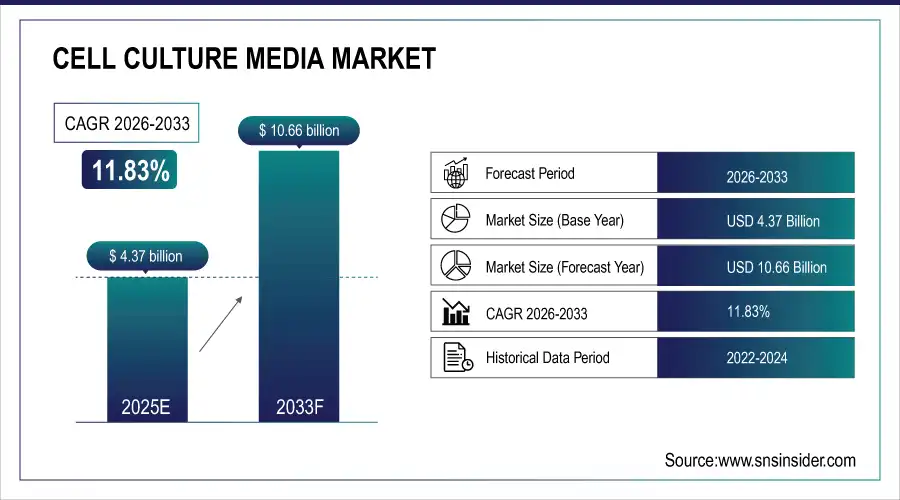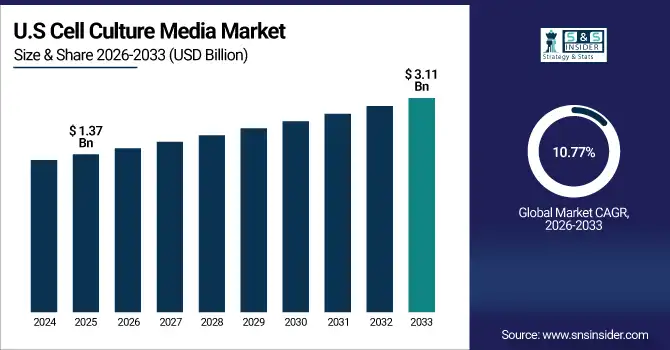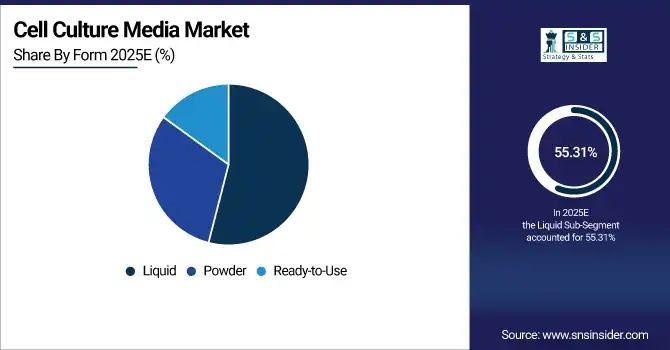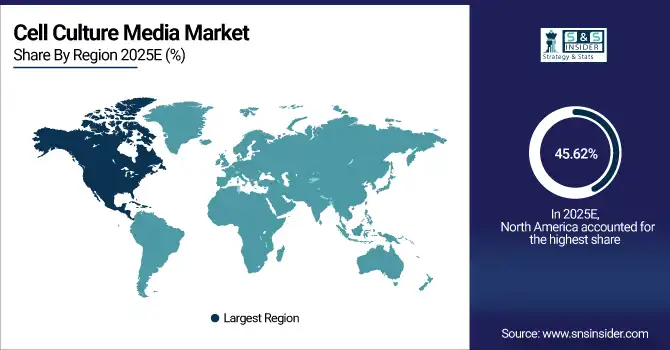Cell Culture Media Market Report Scope & Overview:
The Cell Culture Media Market Size was valued at USD 4.37 Billion in 2025E and is projected to reach USD 10.66 Billion by 2033, growing at a CAGR of 11.83% during the forecast period 2026–2033.
The Cell Culture Media Market analysis report offers an overview of various factors driving market growth. Increasing utilization in biotechnology, pharmaceutical and research along with growing emphasis on stem cell research, drug discovery and biopharmaceutical production are some of the factors propelling market growth.
Cell Culture Media usage reached 1,250 tons in 2025, driven by growing demand from stem cell research, drug discovery, and biopharmaceutical production.
Market Size and Forecast:
-
Market Size in 2025: USD 4.37 Billion
-
Market Size by 2033: USD 10.66 Billion
-
CAGR: 11.83% from 2026 to 2033
-
Base Year: 2025
-
Forecast Period: 2026–2033
-
Historical Data: 2022–2024

To Get more information On Cell Culture Media Market - Request Free Sample Report
Cell Culture Media Market Trends:
-
Growing research in stem cells, regenerative medicine, and personalized medicines is increasing the need for superior cell culture media.
-
Rising prevalence of biopharmaceutical manufacturing and drug discovery are some of the factors fueling the growth of serum-free, chemically defined and pre-developed media formulations.
-
Growing penetration of automated and high throughput laboratory systems is boosting media utilization efficiency in research and clinical laboratories.
-
A strong emphasis on sustainability, fewer animal-based ingredients and environmentally friendly manufacturing processes is informing product development and investment.
-
Rise in biotech and academic research centers around the world are driving the market growth, the exclusive media formulations, and customized solutions for various applications.
U.S. Cell Culture Media Market Insights:
The U.S. Cell Culture Media Market is projected to grow from USD 1.37 Billion in 2025E to USD 3.11 Billion by 2033, at a CAGR of 10.77%. Growth will be led by increasing demand in biopharmaceutical manufacturing, stem cell research and increased use of innovative, serum-free and ready-to-use media in the laboratory.

Cell Culture Media Market Growth Drivers:
-
Rising demand for advanced cell culture media, fueled by stem cell research and biopharmaceutical production expansion.
Rising demand for advanced cell culture media is the primary driver of Cell Culture Media Market Growth. The growth of stem cell research, regenerative medicine and biopharmaceutical production has created a demand for well-defined, serum-free media. Biotech companies, research organisations and hospitals are increasingly taking up the technology. Formulations that are ready-to-use, automation-compatible media and sustainable production techniques all contribute to efficiencies, quality and a wider range of applications, furthering the long trend for market growth.
Cell Culture Media demand grew 9.8% in 2025, driven by expanding stem cell research, biopharmaceutical production, and laboratory adoption.
Cell Culture Media Market Restraints:
-
High costs of advanced media and stringent regulatory requirements are limiting widespread adoption in research and clinical labs.
High costs of advanced cell culture media and stringent regulatory requirements are key restraints for the market. Manufacturers and labs must adhere to numerous regulations for manufacturing, manipulation and use in patient treatment that restrict operational flexibility. High costs and complexity of high-quality, serum-free, chemically defined media deter adoption especially by small research institutions and start-up Biotech companies. The validation standards, safety controls and sustainability issues that markets adopt can act as deterrents to mass deployment on a large scale and to innovation.
Cell Culture Media Market Opportunities:
-
Increasing demand for advanced, serum-free, and customized media offers opportunities for innovation in formulation and application.
Rising demand for advanced, serum-free, and customized cell culture media presents a significant opportunity for market growth. Scientists and biopharmaceutical companies need premium-quality, custom media for stem cell research, drug discovery and regenerative medicine applications. Formulations, automation capability and environmental- friendliness of production facilities are becoming increasingly relevant. This emphasis on customized solution and environment-friendly operation amplifies product manoeuvrability, raises the value of suppliers’ products and instigates sustainable growth in the Cell Culture Media Market.
Customized and serum-free cell culture media accounted for 32% of innovations in 2025, driven by stem cell research and biopharmaceutical production.
Cell Culture Media Market Segmentation Analysis:
-
By Type, Serum-Free held the largest market share of 42.76% in 2025, while Chemically Defined is expected to grow at the fastest CAGR of 12.84% during 2026–2033.
-
By Form, Liquid dominated with a 55.31% share in 2025, while Ready-to-Use is projected to expand at the fastest CAGR of 13.21%.
-
By Application, Biopharmaceutical Production accounted for the highest market share of 38.49% in 2025, and Stem Cell Research is expected to record the fastest CAGR of 14.02%.
-
By End-User, Biotechnology & Pharma Companies held the largest share of 47.88% in 2025, while Research Institutes are expected to grow at the fastest CAGR of 12.67% during the forecast period.
By Type, Serum-Free Dominates While Chemically Defined Expands Rapidly:
Serum-Free segment dominated the market due to its extensive penetration into biopharmaceutical manufacturing, regenerative medicine and large-scale laboratory research. Its robustness, uniformity and minimal animal content make it ideal for quality critical applications. Chemically Defined is the fastest growing segment, boosted by increasing applications in molecularly controlled, reproducible experimentation and advanced cell therapy. High investment in stem cell research, rise in the automation capability, and precise application facilities boosts its adoption.
By Form, Liquid Dominates While Ready-to-Use Expands Rapidly:
Liquid segment dominated the market as it is easily applicable, easy to handle and being widely used in laboratories and clinics. It is suitable for high throughput due to its convenience in large-scale production and is favored by biotech companies. Ready-to-Use is the fastest growing segment with the need for preassembled and contamination-free solutions, saving time with reduced errors. Increased demand in research institutes, hospitals and regenerative medicine programs drives its growth.

By Application, Biopharmaceutical Production Dominates While Stem Cell Research Expands Rapidly:
Biopharmaceutical Production segment dominated the market owing to the production of vaccines, monoclonal antibodies and therapeutic proteins on an industrial scale that require stringent cell culture media. Steady market demand for serum-free and advanced media formulations will be driven by an expanding pharmaceutical segment. Stem Cell Research is the fastest growing segment driven by developments in regenerative medicine, tissue engineering and personalized medicine. Rising research activities and investments, along with high-precision media demand, help expand the market.
By End-User, Biotechnology & Pharma Companies Dominate While Research Institutes Expand Rapidly:
Biotechnology and pharma segment dominated the market as it demands large production facilities, developed R&D infrastructure and ongoing demand for superior cell culture media. These companies generate innovation and sustain ongoing purchase of standard or personalized media. Research Institutes is the fastest growing segment due to increasing academic research, government-funded testing and stem cell studies. Adoption of laboratories and increasing partnership with biotech companies and clinical-research organizations around the world will continue to help them grow in size.
Cell Culture Media Market Regional Analysis:
North America Cell Culture Media Market Insights:
The North America Cell Culture Media Market is dominated by the region, accounting for 45.62% share in 2025, high adoption of the biotechnology & pharmaceutical R&D and production of biopharmaceuticals. Increased investments in stem cell research, regenerative medicine and advanced laboratory infrastructure are driving demand. Growing demand for serum-free and chemically defined media and automation-compatible offerings increase efficiency and reproducibility. Favorable regulatory environments, heavy research funding, Adoption of technology and innovation are likely to ensure market growth in the region over the coming years.

U.S. Cell Culture Media Market Insights:
The U.S. Cell Culture Media Market is projected to be driven by increasing use of serum-free, specialty and custom media in biotechnology, pharmaceutical R&D and regenerative medicine. Growth is driven by the growing research and development in laboratories, government funding for research, rising adoption in stem cell research, and innovative ready-to-use and sustainable media.
Asia-Pacific Cell Culture Media Market Insights:
The Asia-Pacific Cell Culture Media Market is the fastest-growing region, projected at a CAGR of 14.97% during 2026–2033. Growth is based on the continuation of increasing biotechnology and pharmaceutical research along with the expanding capabilities in our stem cell studies and regenerative medicine markets. Important markets are China, India, Japan and Australia. Regional market expansion and accessibility is attributed to rapid urbanization, increased laboratory infrastructure, utilization of novel serum-free & ready-to-use media and supportive government funds.
China Cell Culture Media Market Insights:
The China Cell Culture Media Market growth is propelled by increasing biotechnology and pharmaceutical research, growing laboratory infrastructure and regenerative medicine applications. Growing government funding, uptake of serum-free and ready-to-use media and the advent of modern research institutes and collaborations in China are also factors supporting market growth in the Asia Pacific region.
Europe Cell Culture Media Market Insights:
The Europe Cell Culture Media Market is growing along with the Biotechnology industry, but the market is likely to slow down its growth due to the shortage of skilled professionals, asserts a report published on Market Data Forecast. Germany, UK and France are the major markets. Market growth is based on seamless integration of sensing and treatment functions, discovery of further active molecules that enhance the functioning of internal organs, and support for testing market consolidation creates new vibrant market.
Germany Cell Culture Media Market Insights:
Germany is a key market for Cell Culture Media, due to strong presence of biotechnology, pharmaceutical and research organizations in the country. Demand is driven by adoption in academic and industrial labs. Services are backed by the development of serum-free, ready-to-use media and sustainability projects and a focus on high-quality, reproducible cell culture solutions, thereby cementing Germany’s important role within Europe.
Latin America Cell Culture Media Market Insights:
The Latin America Cell Culture Media Market growth is driven by rising biotechnology and pharmaceutical research, continuously growing food and beverage industry, and developing laboratory technologies. The usability of serum-free and ready to use media, sustainability efforts, and development of research facilities in major regional markets such as Brazil, Mexico, Argentina is expected to drive the market growth.
Middle East and Africa Cell Culture Media Market Insights:
The Middle East & Africa Cell Culture Media Market is forecasted to progress owing to the escalating biotechnology and pharmaceutical research activities, growing demand in academic and clinical laboratories and spreading regenerative medicine research. Government programs, partnership with international research organizations and introduction of serum free & ready to use media are also driving regional market growth.
Cell Culture Media Market Competitive Landscape:
Thermo Fisher Scientific, headquartered in Waltham, Massachusetts, is a leader in scientific research products, including Gibco™ cell culture media, reagents, and laboratory instruments. The company dominates the cell culture media market due to scale, large distribution network and trusted brand. The company sustains itself through its key acquisitions, superior bioprocessing technologies and substantial R&D efforts meant to effectively cater different segments of biotechnology, pharma and research. Blending heritage and innovation, Thermo Fisher continues to enable scientists through reliability, quality and availability.
-
In September 2025, Thermo Fisher Scientific launched Efficient-Pro Medium (+) Insulin, enhancing CHO cell line performance. The medium delivers up to 61% higher titers, faster workflows, and scalable bioprocessing solutions, addressing growing demand for efficient and reliable biopharmaceutical production.
Merck KGaA, based in Darmstadt, Germany, is a leading life sciences and pharmaceutical company, offering a broad portfolio of Millipore Sigma cell culture media, reagents, and laboratory solutions. Its position is underpinned by robust international reach, technological know-how and brand. The group fosters growth through partnerships, product development and sustainable actions. Through a balance of research-driven products and services, we support the life science industry and researchers addressing scientific challenges within pharmaceutical, biotechnology and academic organisations.
-
In January 2025, Merck KGaA acquired HUB Organoids Holding B.V., a pioneer in organoid development. This acquisition expands Merck's cell culture portfolio, enhancing its capabilities in next-generation biology and supporting advancements in drug discovery and regenerative medicine.
Lonza Group, headquartered in Basel, Switzerland, is a leader in providing integrated solutions for pharmaceutical, biotechnology, and specialty ingredient markets. With a cell culture media product line and the ultimate in CDMO services, it excels ensuring biopharmaceutical manufacturers. Lonza relies on large-scale manufacturing capacity, state-of-the-art bioprocess technology and research collaborations to provide high-quality, consistent media products. Leadership is our mission Lonza’s market leadership is rooted in technological innovation, a strong work ethic and commitment to client service, which are part of their DNA since inception.
-
In October 2025, Lonza launched TheraPEAK® 293-GT® Medium, a chemically defined, animal-origin-free solution optimized for AAV production in suspension HEK293 cells. The medium enables scalable, reliable viral vector production, supporting gene therapy and biopharmaceutical research.
Cell Culture Media Market Key Players:
Some of the Cell Culture Media Market Companies are:
-
Thermo Fisher Scientific
-
Merck KGaA
-
Lonza Group
-
Sartorius AG
-
Danaher Corporation (Cytiva)
-
FUJIFILM Irvine Scientific
-
Corning Incorporated
-
Becton, Dickinson and Company (BD)
-
STEMCELL Technologies
-
PromoCell GmbH
-
HiMedia Laboratories
-
Bio-Rad Laboratories
-
Avantor Inc.
-
Ajinomoto Co., Inc.
-
Greiner Bio-One
-
Miltenyi Biotec
-
CellGenix
-
Pan-Biotech
| Report Attributes | Details |
|---|---|
| Market Size in 2025E | USD 4.37 Billion |
| Market Size by 2033 | USD 10.66 Billion |
| CAGR | CAGR of 11.83% From 2026 to 2033 |
| Base Year | 2025E |
| Forecast Period | 2026-2033 |
| Historical Data | 2022-2024 |
| Report Scope & Coverage | Market Size, Segments Analysis, Competitive Landscape, Regional Analysis, DROC & SWOT Analysis, Forecast Outlook |
| Key Segments | • By Type (Serum-Based, Serum-Free, Chemically Defined, Others) • By Form (Liquid, Powder, Ready-to-Use) • By Application (Stem Cell Research, Drug Discovery, Biopharmaceutical Production, Toxicology Studies, Others) • By End-User (Biotechnology & Pharma Companies, Research Institutes, Hospitals & Clinics, Academic & Government Laboratories, Others) |
| Regional Analysis/Coverage | North America (US, Canada), Europe (Germany, UK, France, Italy, Spain, Russia, Poland, Rest of Europe), Asia Pacific (China, India, Japan, South Korea, Australia, ASEAN Countries, Rest of Asia Pacific), Middle East & Africa (UAE, Saudi Arabia, Qatar, South Africa, Rest of Middle East & Africa), Latin America (Brazil, Argentina, Mexico, Colombia, Rest of Latin America). |
| Company Profiles | Thermo Fisher Scientific, Merck KGaA, Lonza Group, Sartorius AG, Danaher Corporation (Cytiva), FUJIFILM Irvine Scientific, Corning Incorporated, Becton, Dickinson and Company (BD), GE Healthcare, STEMCELL Technologies, PromoCell GmbH, HiMedia Laboratories, Bio-Rad Laboratories, Avantor Inc., Caisson Laboratories, Ajinomoto Co., Inc., Greiner Bio-One, Miltenyi Biotec, CellGenix, Pan-Biotech |

